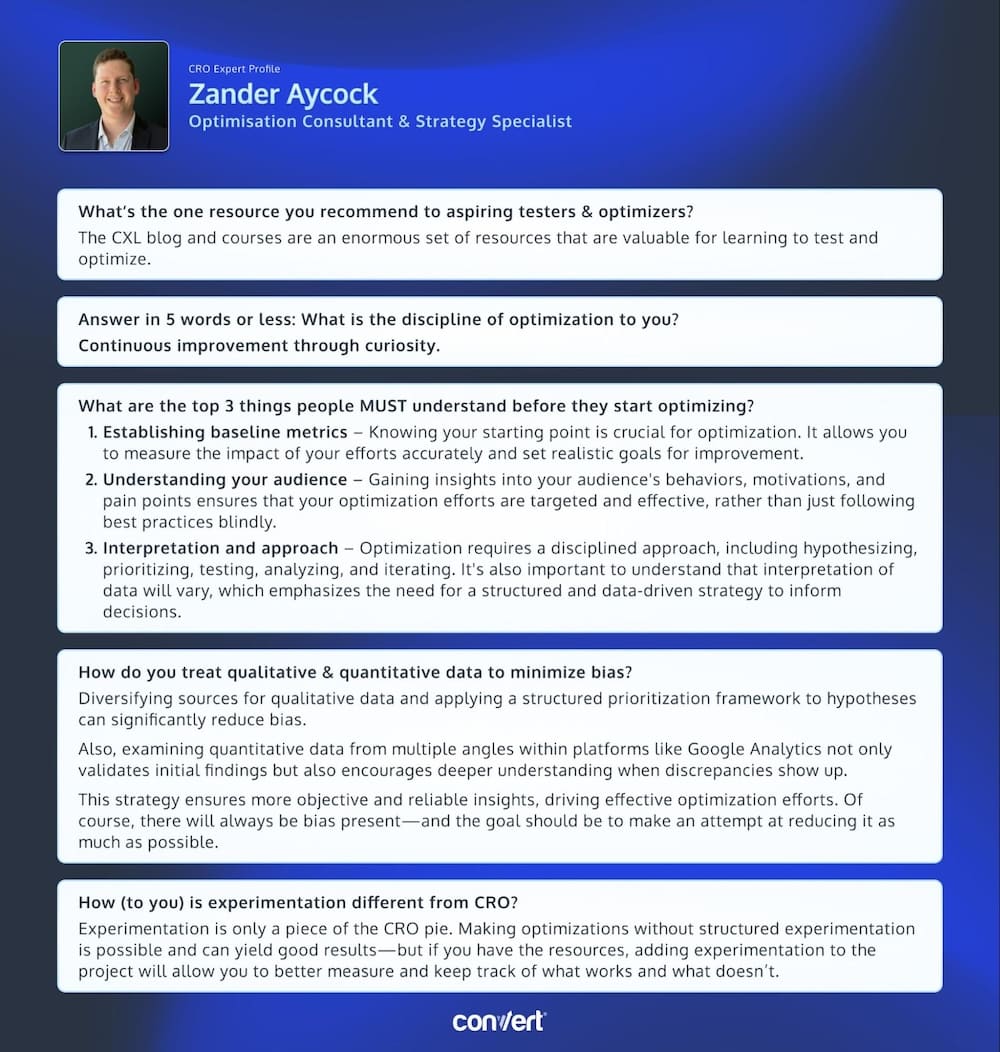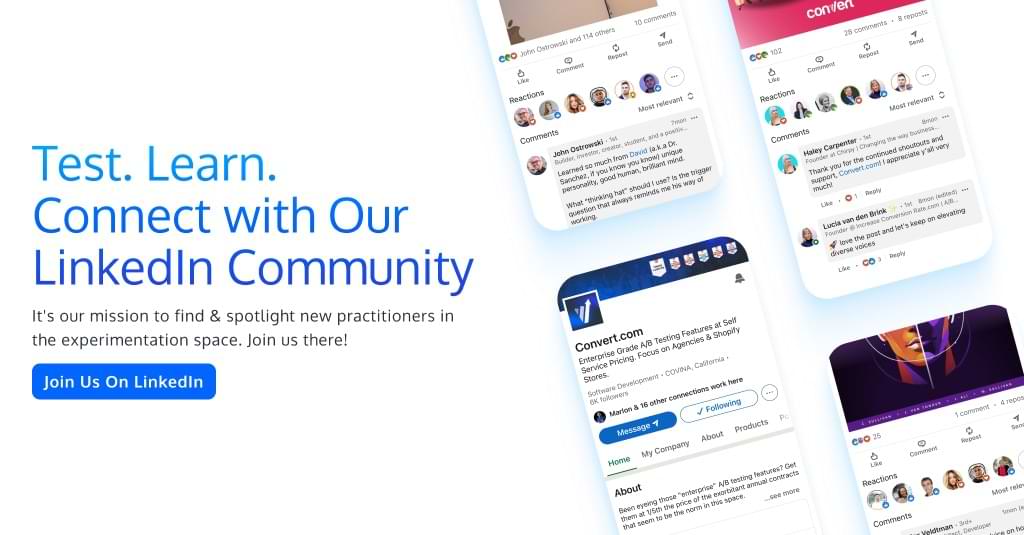Testing Mind Map Series: How to Think Like a CRO Pro (Part 58)
Interview with Zander Aycock
Every couple of weeks, we get up close and personal with some of the brightest minds in the CRO and experimentation community.
We’re on a mission to discover what lies behind their success. Get real answers to your toughest questions. Share hidden gems and unique insights you won’t find in the books. Condense years of real-world experience into actionable tactics and strategies.
This week, we’re chatting with Zander Aycock, Conversion Specialist at Johnson Group, an integrated marketing & creative solutions agency, specializing in empowering online brands to forge deeper brand connections and drive more profitable conversions.
Zander, tell us about yourself. What inspired you to get into testing & optimization?
I started in digital marketing in 2015, but my interest began even earlier when I was promoting my band’s concerts—both digital and print. Most of my work has been in e-commerce, but I’ve also helped hundreds of small businesses like shops, restaurants, and home services companies. Now, I’m working for a creative agency in Tennessee, working with larger companies.
My inspiration for experimentation came early in my career—from improving product detail pages on Amazon, where I saw a direct impact on sales and conversion rates. I love testing and optimization because small tweaks can have a significant impact on sales and conversions. It’s exciting to see substantial results from incremental changes.
How many years have you been testing for?
I’ve been A/B testing since 2021 and have always carried curiosity to learn and make improvements.
What’s the one resource you recommend to aspiring testers & optimizers?
The CXL blog and courses are an enormous set of resources that are valuable for learning to test and optimize.
Answer in 5 words or less: What is the discipline of optimization to you?
Continuous improvement through curiosity.
What are the top 3 things people MUST understand before they start optimizing?
- Establishing baseline metrics—Knowing your starting point is crucial for optimization. It allows you to measure the impact of your efforts accurately and set realistic goals for improvement.
- Understanding your audience—Gaining insights into your audience’s behaviors, motivations, and pain points ensures that your optimization efforts are targeted and effective, rather than just following best practices blindly.
- Interpretation and approach—Optimization requires a disciplined approach, including hypothesizing, prioritizing, testing, analyzing, and iterating. It’s also important to understand that interpretation of data will vary, which emphasizes the need for a structured and data-driven strategy to inform decisions.
How do you treat qualitative & quantitative data to minimize bias?
Diversifying sources for qualitative data and applying a structured prioritization framework to hypotheses can significantly reduce bias.
Also, examining quantitative data from multiple angles within platforms like Google Analytics not only validates initial findings but also encourages deeper understanding when discrepancies show up.
This strategy ensures more objective and reliable insights, driving effective optimization efforts. Of course, there will always be bias present—and the goal should be to make an attempt at reducing it as much as possible.
How (to you) is experimentation different from CRO?
Experimentation is only a piece of the CRO pie. Making optimizations without structured experimentation is possible and can yield good results—but if you have the resources, adding experimentation to the project will allow you to better measure and keep track of what works and what doesn’t.
Talk to us about some of the unique experiments you’ve run over the years.
Some of the most unique experiments are the ones where you are confident something will have a positive impact, but it proves you wrong.
One interesting test involved a food delivery service that made deliveries on specific days of the week. We noticed a significant drop-off between users browsing the product pages and those adding items to their cart. The hypothesis was that by introducing a countdown timer on the product pages, showing how much time was left to qualify for next-day delivery, it would instill a sense of urgency and boost conversions. Contrary to expectations, this change actually led to a 7% decrease in conversion rate.
Our thanks go out to Zander for taking part in this interview! To our lovely readers, we hope you found the insights useful and encourage you to apply them in your own optimization efforts.
Don’t forget to check back twice a month for more enlightening interviews! And if you haven’t already, check out our past interviews with CRO pros Gursimran Gujral, Haley Carpenter, Rishi Rawat, Sina Fak, Eden Bidani, Jakub Linowski, Shiva Manjunath, Deborah O’Malley, Andra Baragan, Rich Page, Ruben de Boer, Abi Hough, Alex Birkett, John Ostrowski, Ryan Levander, Ryan Thomas, Bhavik Patel, Siobhan Solberg, Tim Mehta, Rommil Santiago, Steph Le Prevost, Nils Koppelmann, Danielle Schwolow, Kevin Szpak, Marianne Stjernvall, Christoph Böcker, Max Bradley, Samuel Hess, Riccardo Vandra, Lukas Petrauskas, Gabriela Florea, Sean Clanchy, Ryan Webb, Tracy Laranjo, Lucia van den Brink, LeAnn Reyes, Lucrezia Platé, Daniel Jones, May Chin, Kyle Hearnshaw, Gerda Vogt-Thomas, Melanie Kyrklund, Sahil Patel, Lucas Vos, David Sanchez del Real, Oliver Kenyon, David Stepien, Maria Luiza de Lange, Callum Dreniw, Shirley Lee, Rúben Marinheiro, Lorik Mullaademi, Sergio Simarro Villalba, Georgiana Hunter-Cozens, Asmir Muminovic, Edd Saunders, and our latest with Marc Uitterhoeve.
Written By
Zander Aycock
Edited By
Carmen Apostu



